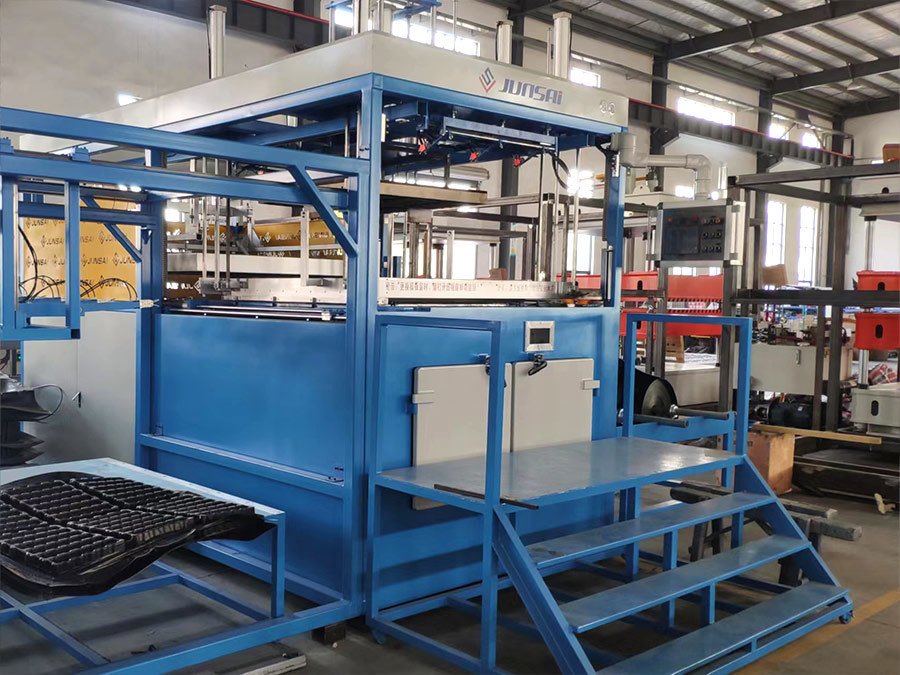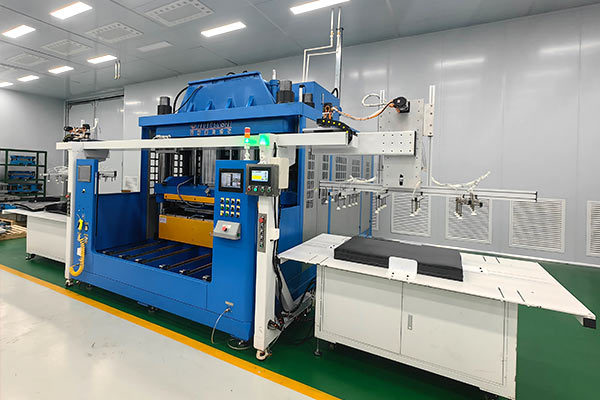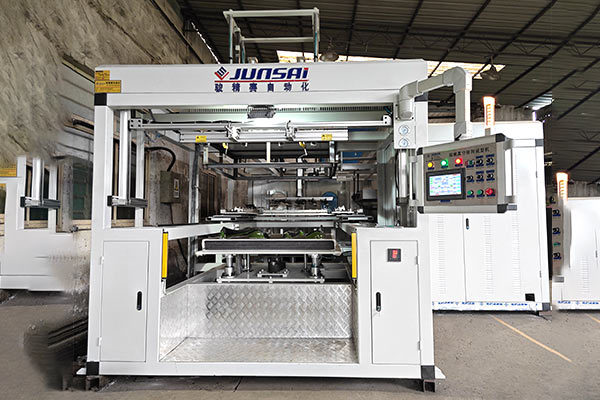Unlocking Efficiency: The Benefits of the Newest Small Thermoforming Machines
2025-07-25
Unlocking Efficiency: The Benefits of the Newest Small Thermoforming Machines
Table of Contents
1. Introduction to Small Thermoforming Machines
2. What Are Thermoforming Machines?
3. Types of Small Thermoforming Machines
3.1 Vacuum Thermoforming Machines
3.2 Pressure Thermoforming Machines
3.3 Thermoforming vs. Injection Molding
Unlocking Efficiency: The Benefits of the Newest Small Thermoforming Machines
Table of Contents
- 1. Introduction to Small Thermoforming Machines
- 2. What Are Thermoforming Machines?
- 3. Types of Small Thermoforming Machines
- 3.1 Vacuum Thermoforming Machines
- 3.2 Pressure Thermoforming Machines
- 3.3 Thermoforming vs. Injection Molding
- 4. Advantages of Small Thermoforming Machines
- 4.1 Enhanced Efficiency
- 4.2 Cost-Effectiveness
- 4.3 Flexibility and Customization
- 4.4 Quality and Consistency
- 5. Application Industries for Small Thermoforming Machines
- 6. Implementing Small Thermoforming Machines in Your Production Line
- 7. Future Trends in Thermoforming Technology
- 8. FAQs
- 9. Conclusion
1. Introduction to Small Thermoforming Machines
In the fast-paced world of manufacturing, the quest for efficiency is never-ending. **Small thermoforming machines** have emerged as a game-changing solution, allowing businesses to produce high-quality products with reduced turnaround times and lower costs. These compact machines cater to a variety of applications, making them an indispensable asset in several industries. In this article, we will delve into the numerous benefits of the latest small thermoforming machines and their impact on operational efficiency.
2. What Are Thermoforming Machines?
**Thermoforming machines** are specialized pieces of equipment used to shape plastic sheets into specific forms by heating them until they become pliable. Once heated, these sheets are molded into desired shapes, often using molds, and then cooled to solidify the final product. This process can be performed using various techniques, including vacuum, pressure, and mechanical methods, allowing for a diverse range of applications.
3. Types of Small Thermoforming Machines
Understanding the types of small thermoforming machines available can help manufacturers select the right type for their specific needs.
3.1 Vacuum Thermoforming Machines
Vacuum thermoforming is the most common technique used. In this method, a heated plastic sheet is placed over a mold, and a vacuum is applied to suck the sheet down onto the mold's surface. This process creates intricate shapes and is particularly effective for producing packaging solutions, trays, and containers.
3.2 Pressure Thermoforming Machines
Pressure thermoforming involves applying air pressure to the heated sheet, pushing it into the mold. This technique is more suited for creating complex shapes and thicker materials. It is often used in sectors that require durable components, such as automotive and aerospace industries.
3.3 Thermoforming vs. Injection Molding
While both thermoforming and injection molding are effective for plastic shaping, they differ significantly. Injection molding involves injecting molten plastic into a mold, creating products with excellent finish and precision but often at higher production costs. In contrast, thermoforming is more cost-effective for low to medium volume production, making it ideal for startups and smaller companies looking to minimize expenses.
4. Advantages of Small Thermoforming Machines
Small thermoforming machines have several advantages over traditional manufacturing methods, making them an attractive option for many companies.
4.1 Enhanced Efficiency
The newest small thermoforming machines are designed for optimal performance, allowing for faster cycle times and reduced product changeover durations. **Increased efficiency** translates directly into higher productivity levels, enabling companies to meet growing market demands without sacrificing quality.
4.2 Cost-Effectiveness
Investing in small thermoforming machines can result in significant cost savings. Their ability to produce high-quality products quickly reduces labor and material costs, allowing manufacturers to maximize their ROI. Additionally, smaller machines require less floor space and energy, further decreasing operational expenses.
4.3 Flexibility and Customization
One of the standout features of small thermoforming machines is their **flexibility**. They can easily adapt to different materials and product specifications, allowing businesses to customize their offerings. This adaptability is crucial in today’s market, where demand for personalized products is ever-increasing.
4.4 Quality and Consistency
With advancements in technology, the latest small thermoforming machines offer superior **quality control** capabilities. They produce uniform products with tight tolerances, ensuring that every item meets industry standards. This consistency helps maintain brand reputation and customer satisfaction.
5. Application Industries for Small Thermoforming Machines
Small thermoforming machines find applications across various industries, showcasing their versatility and efficacy.
5.1 Packaging Industry
In the packaging sector, small thermoforming machines are vital for creating custom trays, clamshells, and containers. Their ability to produce lightweight yet sturdy packaging solutions is invaluable for food, pharmaceuticals, and consumer goods.
5.2 Automotive Industry
The automotive industry benefits from small thermoforming machines for producing dashboard components, panels, and interior trim. The precision and durability of thermoformed parts enhance vehicle aesthetics and performance.
5.3 Medical Industry
In healthcare, small thermoforming machines are instrumental in creating sterile packaging for medical devices and consumables. Their ability to produce custom shapes ensures the safety and reliability of medical products.
6. Implementing Small Thermoforming Machines in Your Production Line
Transitioning to small thermoforming machines requires careful planning and consideration. Here are key steps to ensure successful integration:
6.1 Assessing Production Needs
Begin by analyzing your current production processes and identifying areas where small thermoforming machines can enhance efficiency. Understanding your specific requirements will guide your selection of the right equipment.
6.2 Training and Development
Investing in staff training is crucial for maximizing the potential of new machines. Ensure your team is well-versed in operating and maintaining small thermoforming machines to minimize downtime and optimize productivity.
6.3 Monitoring and Optimization
Once implemented, it is essential to track production metrics and continuously optimize processes. Regularly reviewing performance will help identify improvement areas and ensure the equipment operates at peak efficiency.
7. Future Trends in Thermoforming Technology
As technology advances, we can expect significant innovations in small thermoforming machines. Some future trends include:
7.1 Automation and Smart Technology
The integration of automation and smart technology will streamline operations, reducing manual input and enhancing precision. These advancements will allow for real-time monitoring and data analysis, improving overall efficiency.
7.2 Sustainable Materials
As the industry shifts towards sustainability, small thermoforming machines will increasingly use eco-friendly materials. This trend will align manufacturing processes with environmental standards and consumer expectations.
7.3 Improved Energy Efficiency
Future models of small thermoforming machines will prioritize energy efficiency, reducing the carbon footprint of manufacturing processes and lowering operational costs.
8. FAQs
8.1 What is the typical lifespan of a small thermoforming machine?
The lifespan of a small thermoforming machine can vary based on usage, maintenance, and brand. Generally, with proper care, these machines can last between 10 to 15 years.
8.2 How do small thermoforming machines compare in price?
Small thermoforming machines tend to be more cost-effective than larger models, with prices ranging widely based on features and capabilities. It is essential to assess your production needs to find the right fit.
8.3 Can small thermoforming machines handle complex designs?
Yes, modern small thermoforming machines can accommodate complex designs, especially when utilizing pressure thermoforming techniques. This adaptability enables businesses to create intricate products effectively.
8.4 What materials can be used in small thermoforming machines?
Small thermoforming machines are compatible with various materials, including PET, PVC, PS, and polypropylene. The choice of material often depends on the intended application.
8.5 How do I maintain my small thermoforming machine?
Regular maintenance is crucial for keeping your small thermoforming machine in optimal condition. This includes routine cleaning, lubrication, and inspections, as well as following the manufacturer's guidelines.
9. Conclusion
The newest small thermoforming machines represent a significant advancement in manufacturing technology, offering enhanced efficiency, cost-effectiveness, and versatility. By integrating these machines into production lines, businesses can improve quality, reduce lead times, and remain competitive in a demanding market. With the continuous evolution of thermoforming technology, companies can look forward to even greater innovations that will shape the future of manufacturing. Embracing these advancements can unlock new opportunities and drive success in various industries, making small thermoforming machines an essential investment for forward-thinking manufacturers.
Keywords:
Related information
Exploring the Advantages of Quality Semi-Automatic Thermoforming Machines
In the realm of manufacturing and packaging machinery, quality semi-automatic thermoforming machines stand out as versatile and efficient tools for producing various plastic products. These machines operate by heating thermoplastic sheets until soft, then forming them into desired shapes using molds, and finally cooling them to maintain their structure. The semi-automatic aspect means that while c
2025-07-26
Unlocking Efficiency: The Benefits of the Newest Small Thermoforming Machines
Unlocking Efficiency: The Benefits of the Newest Small Thermoforming Machines
Table of Contents
1. Introduction to Small Thermoforming Machines
2. What Are Thermoforming Machines?
3. Types of Small Thermoforming Machines
3.1 Vacuum Thermoforming Machines
3.2 Pressure Thermoforming Machines
3.3 Thermoforming vs. Injection Molding
2025-07-25
Exploring the Benefits of Affordable Plate Forming Machines for Your Manufacturing Needs
In the realm of manufacturing and processing machinery, particularly in the packaging sector, the demand for efficient and reliable equipment is paramount. One notable piece of equipment that has gained attention is the cheap plate forming machine. These machines are designed to shape and form materials into specified configurations, often utilized in various packaging applications. Understanding
2025-07-24












